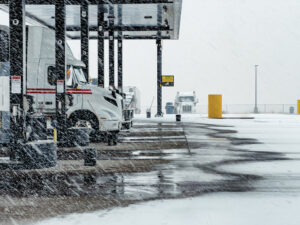BEAVERTON, Ore. — With supply chains adjusting to Hurricane Helene-related cleanup in the Southeast and uncertainty over a strike at East Coast and Gulf Coast ports, the total number of loads posted on DAT One increased 14.9% to 2.01 million week over week. That’s the highest number of available loads since Week 29 (July 7-13).
Dry Vans
▲ Van loads: 952,242, up 16.5% week over week
▼ Van equipment: 169,815, down 21.5%
▲ Linehaul rate: $1.65 net fuel, up 4 cents
▲ Load-to-truck ratio: 4.5, up from 3.8
Reefers
▲ Reefer loads: 402,839, up 16.5% week over week
▼ Reefer equipment: 63,891, down 5.6%
— Linehaul rate: $1.97 net fuel, unchanged for the third straight week
▲ Load-to-truck ratio: 6.3, up from 5.1
Flatbeds
▲ Flatbed loads: 658,647, up 11.5% week over week
▼ Flatbed equipment: 41,888, down 7.2%
▲ Linehaul rate: $2.00 net fuel, up 1 cent
▲ Load-to-truck ratio: 15.7, up from 13.1. This is the sixth consecutive week of increases
The ILA strike was short-lived but had an impact on spot load volume.
“The 20 freight markets adjacent to ports affected by the ILA strike last week saw a 5% reduction in van load posts compared to the previous week, said Dean Croke, DAT industry analyst. “There was a 7% decrease in spot van loads posted in DAT’s Elizabeth, N.J., market and a 6% decrease in Savannah, Georgia.”
Truck posts fell 16.3% to 275,594 as velocity in freight networks on the East Coast slowed dramatically due to bad weather and, to a lesser degree, the ILA strike.
Hurricane Helene’s impact on spot truckload freight was regional and considerable.
“Due to constrained capacity, the weekly average dry van linehaul rates increased by 4 cents to $1.65 a mile,” Croke said. “In DAT’s Southeast region, inbound and outbound rates increased by an average of 10 cents a mile compared to the previous week. In DAT’s Atlanta market, the average linehaul van rate was up 7 cents to $1.53 a mile despite a 3% decrease in load volume compared to the previous week. The average linehaul reefer rate in Atlanta increased by 10 cents to $2.13 a mile on a 7% decrease in volume.”
Storm cleanup led to higher demand for flatbed capacity.
According to Croke, the number of flatbed load posts was 23% higher year over year, and the weekly flatbed load-to-truck ratio was the highest in three years for Week 40. The number of flatbed load posts increased by 14% week over week in the Southeast Region and was up 68% week over week in DAT’s Tallahassee market, where Hurricane Helene made landfall. Flatbed load posts in Houston and New Orleans increased by 27% compared to the previous week.
In Alabama, Mississippi and Georgia, outbound flatbed load volumes plunged by 40% week over week. Flatbed load volumes into the same states jumped by 44%, and the average spot linehaul rate rose 7% to $2.45 a mile. Freight markets in the path of Hurricane Helene saw outbound freight volumes drop 17% week over week while spot rates increased by 8 cents to $2.29 a mile. That’s 30 cents higher than the same week last year.
Preparations for Hurricane Milton followed a familiar pattern.
- Before the storm, shippers and FEMA rush to move freight in and out of the area where the storm is expected to make landfall, and truckload rates rise sharply.
- During the storm, nothing moves in or out of the affected area. FEMA and other organizations will move emergency relief supplies to locations just outside the storm zone so they’re ready to act as soon as roads are clear.
- After the storm, fuel and outbound loads may be scarce, travel can be treacherous, and regulations for hours of service may shift. Emergency supplies are brought in and inbound rates increase. Van and reefer freight move in first, followed by flatbeds hauling construction equipment and materials.
Maxwell Air Force Base in Alabama is the staging ground for much of the federal government’s response to Hurricanes Helene and Milton. Nearly 450 truckloads of supplies arrived during the week ahead of Helene, the bulk of which came from FEMA’s Atlanta distribution center. FEMA loads typically move under contract with approved carriers.












